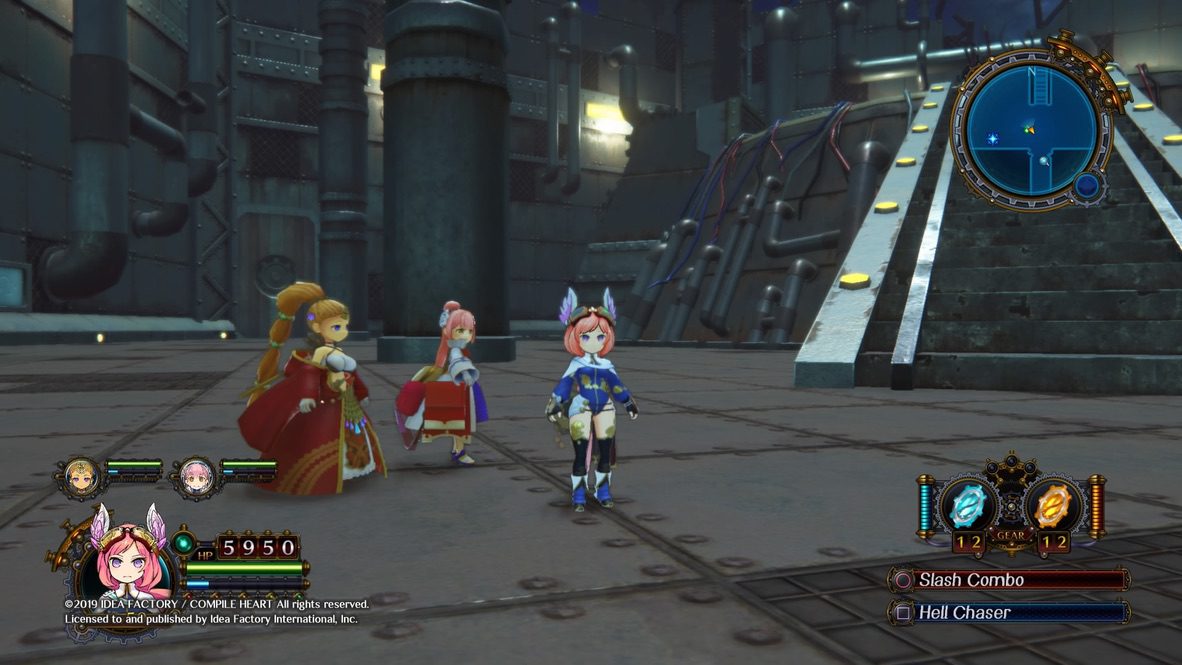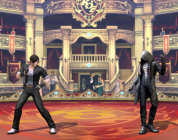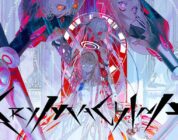You know something is wrong with a game when the last thing you write in your notes is “the soundtrack is the best part of this undeveloped, poorly plotted game.” Arc of Alchemist is a JRPG that lacks about as much entertainment and artistic value as it does alchemy. Mind you, alchemy never actually comes up in the game. While Arc is functionally playable, the unrefined controls, the hackneyed characters and plot, and the unimaginative combat made it about as enjoyable as a crummy soap opera that you might turn on in the background and ignore while making dinner.
First Impressions
First impressions of Arc of Alchemist were promising. While the cover art of what looked like some chibi magical girls was a little saccharine, the game launched straight into its title screen cinematic when turned on. That was a point in its favor. I cannot tell you how many times I have turned on a game’s title screen and waited for five or ten minutes to see whether there was a secret cinematic involved. Unfortunately, however, starting the game launches that same cinematic. Turns out it was just the opening credits. Still, the opening song, performed by someone named Matsushita, was enjoyable! After that, though, everything went downhill.
Arc’s title menu gave me my first look at the character designs. To put it bluntly, Arc is trying to cash in on the female objectification market, pairing skimpy and “flattering” outfits with the men’s serious or more regal clothing. The prologue cinematic, right after the credits, uses a 2D art style reminiscent of Banksy. Unfortunately, that art style never reappears in the entire game. Even more unfortunate, the story they tell of a happy, optimistic girl born to a war-torn world gets immediately discarded once the game starts. That girl, who was once happy with a bare, minimalist life, is the protagonist Quinn Bravesford and she is just waiting to die from the moment the game starts. Literally.
As she surveys a dying, empty world, her wish for a meaningful death is almost the first thing that we hear from Quinn. Maybe we would see how she lost her innocence as the game went on, though! Maybe we would see what changed her from that cheerful girl into the fatalistic military leader that we see now!
Nope.
Never happens.
The protagonist’s past is never addressed, nor is her change from her original personality. Frankly, since the developers were not going to explore Quinn’s past, then they would have done better to just remove her story from the prologue. It left an unfulfilled expectation that was never addressed, even after beating the game, and that left niggling questions.
Actually Playing
Once the game actually begins, it is clear that the developers had bitten off more than they could chew. For one, the graphics would have been far more at home on my old Nintendo DS than on a PS4. Before you can even play, though, the game throws much of the player’s manual at us without so much as a tutorial. In that same initial onslaught of information, the game even warns us that “the controls may change depending on the field.” That is a good warning, but not at all encouraging, especially when we were still trying to learn how to use said controls in the first place. Then again, the controls never actually change as warned, so maybe this was another mechanic that they did not have time to include.
From there, the controls are noticeably clunky. While roaming an open world, 3D map, you can only move in eight directions, despite using a joystick. In combat, this results in frequently missing with ranged and melee attacks alike unless you lock on to an enemy. However, the game fails to tell you that you are even capable of locking on unless you progress a certain distance then decide to look into the player’s manual again for any updates.
There are a whole slew of mechanics such as dodging that they just never bother to mention unless you look them up! It was like they had handed us an instruction manual, but tore out half of the pages, then reattached some of them as we went along, but didn’t tell us which ones they were replacing until we looked. Even by the time they said they were done, we were still missing a third of the instructions!

Second to last boss kept summoning enemies, and some of them landed on random objects. Made it nearly impossible to hurt them because you cannot aim up and ranged attacks are weak.
The mechanics themselves are a mess too in Arc of Alchemist. For one, there are little bits around the map called “gimmicks” and that is all they are. Gimmicks. The player is supposed to use a matching, expendable ability on each type of gimmick in order to unlock a new path or find hidden resources. Maybe this was supposed to pressure us into learning to conserve our ability usage. However, you can always simply jog back to the nearest camp site and replenish your abilities and inventory in an instant without respawning enemies. Then you can tackle the gimmick, which is permanently removed once solved. It really seems like the gimmicks are only there because the developers felt obliged to fulfill popular exploration RPG tropes, regardless of how poorly implemented they were.
A Not-So Immersive World
More of those tropes include large, open world stages and resource grinding. Open world stages are wonderful IF there is something worth exploring. However, Arc of Alchemist fell into the same bad practice that many other games of its genre do by creating huge, monotonous stages that scarcely reward exploration. Everything in the game is desert-themed until the end. That is fine in itself, however, the developers seem to have never looked at a Georgia O’Keeffe painting or, hell, even been to a real desert.
With exception for the night sky (which is lovely and reflects a healthy amount of crafting and attention), the landscape ignores most of the things that make deserts interesting or beautiful. There was minimal attention to different kinds of rocks, how shadows play over the landscape, or how the sun might turn the stone pink or blood red. Instead, almost everything in Arc of Alchemist is in variations of the same three basic colors: rust, tan, and black. Heck, the only plant life they included was the token cactus, and only one kind of cactus at that! You know the kind I’m talking about. It is as though the designers had looked at a picture of the Grand Canyon and the Sahara then copied and pasted those color pallets and scenes all over the game.

See this? This is only a quarter of the whole room and there is NOTHING in here. Waste of time to explore, like most of the game.
Then they decided to throw random traps into the desert that, even in the context of the long concluded wars, seem useless and out of place. I mean, why would a group of rotating spike traps or walls pop out of the earth in the middle of open space when you can easily go around them? It’s not exactly a good strategy if you are trying to harm an invading force. In the developers’ favor, though, the threat of such traps does make the player think twice about sprinting about carelessly. Still, the traps are far from lethal, so go ahead and keep sprinting; It matters little.
As if the boring scenery was not bad enough, there is a lot of it. Sometimes you can find treasure chests or collection points for resources, but most of the time you see those while moving in a straight line between objectives anyhow. There are so few things to collect on the fringes of the maps that there is little reward for exploring unless you are looking to fight more monsters. Although, combat is not nearly interesting or fun enough to be considered a reward. Most of the time, I simply ran past the enemies because they were not worth the time.
Even without fighting, you could be sacrificing fifteen minutes in going to these remote, treasure-less spots. Yet doing so does not even teach you more about the world! You just find another rocky dead end and have to trek back. Some resources are quite useful, though, so I kept wandering, hoping that I would find a little gold mine somewhere. Then again, the collection points respawn whenever you camp. Eventually, I just looked for convenient collection points then respawned them every few minutes or so.
Upgrading
These resources can be used to upgrade your base. Upgrading your base unlocks more items that you can buy, raises the characters’ level caps, and slightly expands some of your item inventory. This includes a city building mechanic, yet you have no hints as to which building configurations work well. It devolves into fumbling around with trial and error until you get the arrangement correct while the slightest change causes your base’s stats to plummet like a narcoleptic seagull.
Money and resources can also go into upgrading your team. Arc of Alchemist’s enemies become more difficult rather quickly and leveling up via combat takes too long. Instead, you can spend resources to improve specific stats for individual characters. Although, this requires a ton of money and goods. I only ever wanted to use the same three characters; I simply buffed them while the other seven languished. Level grinding takes far too long, so I just harvested resources and spent enough money to recoup our national deficit on improving my characters’ stats and equipment. If I failed to do so at any point, I would be promptly stomped by whatever boss came next. Skill has nothing to do with it. Then again, the story was not exactly intriguing enough to compel progression, so it all felt somewhat pointless.
How The Writers Failed The Story
As I said before, Arc of Alchemist’s story starts well. A happy girl is now a jaded warrior and leader in a world destroyed by mankind’s greed and wrath. Soon though, Arc demonstrates how an interesting setting can be rendered bland with terrible storytelling. The characters have nothing left in this game except for hope that some “great power” will save humanity. However, even from the start, they recognize that this as a last-ditch fantasy. Thus the only meaning that their lives have, as far as Quinn can tell, is determined by how they die. This reminded me of a scene from The Lion in Winter, where three characters await execution. One swears that he will fight back until he is killed. One of his cellmates says “as if the way one falls mattered.”
He simply replies “When the fall is all there is, it matters.”
I had expected Arc of Alchemist to explore this issue. This is a grim, yet intriguing subject that touches upon the persistent question “What is the meaning of life?” However, as with most everything else, Arc proceeded to disappoint. The subject only appears a couple of times and resolves in the most stereotypical, boring ways possible: “I’ll die for my friends” and “Oh, maybe I don’t want to die after all.”
With proper character development, even those tired tropes could have been heartfelt, yet the characters were almost unflinchingly static. Each was simply a typical anime archetype, including the angry little girl who wants to be treated as an adult, the motherly figure, the clueless hard-ass, the mysterious revenge seeker, you get the idea. . . Nothing in their actions demonstrates character growth. Instead, we are simply told that they change. In fact, that is a recurring theme with the entire story.
The Main Plot Point
First things first, and a major spoiler warning: the characters of Arc of Alchemist were actually on the moon the whole time. Mankind had destroyed the earth’s environment, forcing them to evacuate the species through a wormhole (of all things) to the newly terraformed moon. That’s the big plot twist, which honestly caught me off guard.
Yet somehow everyone forgot that they were on a different planet over the course of a thousand years, which is really not long in a historical sense, especially considering that this society seems to have a healthy scientific community. Furthermore, the game gives you no clues as to that revelation anyhow, making it spring as if from thin air. Heck, one character even says “Wait, that moon that we see in the night sky is actually the earth?!”
Moon? What moon? I see lots of stars, but nothing else.
It isn’t until the last thirty minutes of the game that you can see the earth, which is blatantly the earth and not the moon! You can see continents and forests on it, for crying out loud! Then, when the climactic moment arrives and Quinn sends all of humanity back to Earth, yet condemns herself to a solitary life on the moon in doing so, we do not even see it happen. The characters are screaming at her to not sacrifice herself one moment and then the scene cuts to a view of Quinn saying “It looks like everyone made it back to Earth.”
Seriously? Arc‘s developers were not even going to animate the little black portal that shows up whenever enemies appear? *groan* That really would not have taken much effort. Also, whose bright idea was it to rip open a rift in spacetime just to move a bunch of people from the earth to the moon?! I can just imagine the conversation.
“Space shuttles? Why would we move people in shuttles to the moon? Let’s just create a tear in the fabric of reality that might turn into a black hole and engulf our entire solar system! That sounds like way more fun!”
To top it off, there is no evidence that humanity has learned from its errors. They destroyed the earth a thousand years ago, terraformed the moon to escape, then destroyed that too and suddenly the characters think that everything will be hunky-dory if they go back? Just as alchemy does not play a role in this story, neither does learning from history, it seems.
Happily Concluded
I could continue to nitpick Arc of Alchemist for another two or three thousand words, talking more about the poor mechanics, the cardboard cutout anime characters, the uninteresting plot, and the shallow visual design. However, I imagine that my editor and you the reader would be a bit irritated if I did. Instead, I will leave you with this.
If you are thinking about getting Arc of Alchemist, here is a bit of advice about playing it:
Don’t.
More information about Arc of Alchemist can be found on the official website. A digital PS4 copy was provided for the purpose of review.
For more review content, check out my thoughts on the recently released Kawaii Deathu Desu, an anime title focusing on idol culture that also fails in a lot of areas. Alex also recently covered My Hero One’s Justice 2, a fighting game based on the popular shonen series. Jonathan also put out some thoughts on Granblue Fantasy: Versus, a beginner-friendly fighting game based off of the popular gacha game.







